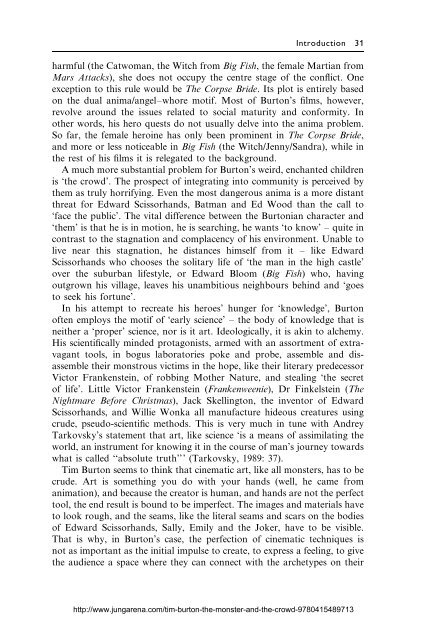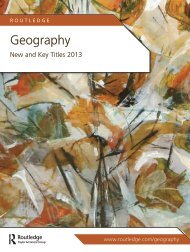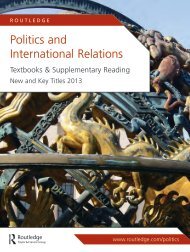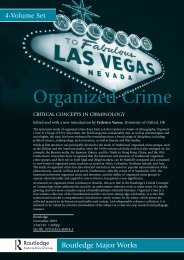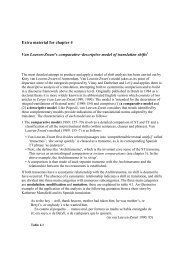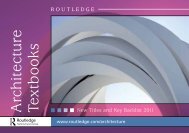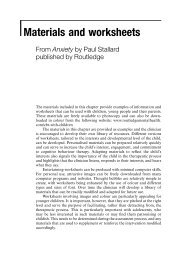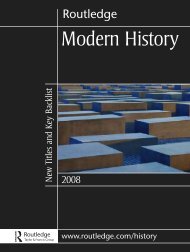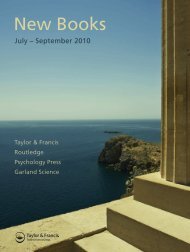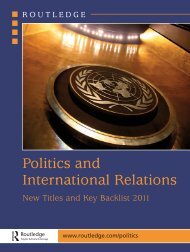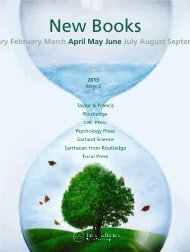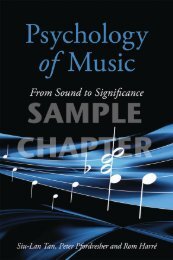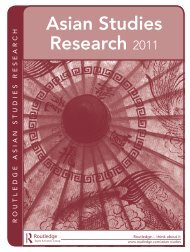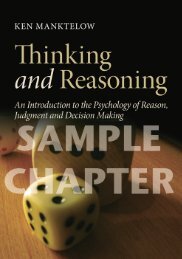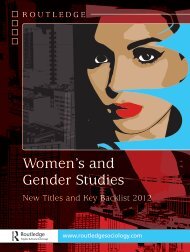Tim Burton: The Monster and the Crowd - A Post-Jungian Perspective
Tim Burton: The Monster and the Crowd - A Post-Jungian Perspective
Tim Burton: The Monster and the Crowd - A Post-Jungian Perspective
You also want an ePaper? Increase the reach of your titles
YUMPU automatically turns print PDFs into web optimized ePapers that Google loves.
Introduction 31<br />
harmful (<strong>the</strong> Catwoman, <strong>the</strong> Witch from Big Fish, <strong>the</strong> female Martian from<br />
Mars Attacks), she does not occupy <strong>the</strong> centre stage of <strong>the</strong> con¯ict. One<br />
exception to this rule would be <strong>The</strong> Corpse Bride. Its plot is entirely based<br />
on <strong>the</strong> dual anima/angel±whore motif. Most of <strong>Burton</strong>'s ®lms, however,<br />
revolve around <strong>the</strong> issues related to social maturity <strong>and</strong> conformity. In<br />
o<strong>the</strong>r words, his hero quests do not usually delve into <strong>the</strong> anima problem.<br />
So far, <strong>the</strong> female heroine has only been prominent in <strong>The</strong> Corpse Bride,<br />
<strong>and</strong> more or less noticeable in Big Fish (<strong>the</strong> Witch/Jenny/S<strong>and</strong>ra), while in<br />
<strong>the</strong> rest of his ®lms it is relegated to <strong>the</strong> background.<br />
A much more substantial problem for <strong>Burton</strong>'s weird, enchanted children<br />
is `<strong>the</strong> crowd'. <strong>The</strong> prospect of integrating into community is perceived by<br />
<strong>the</strong>m as truly horrifying. Even <strong>the</strong> most dangerous anima is a more distant<br />
threat for Edward Scissorh<strong>and</strong>s, Batman <strong>and</strong> Ed Wood than <strong>the</strong> call to<br />
`face <strong>the</strong> public'. <strong>The</strong> vital difference between <strong>the</strong> <strong>Burton</strong>ian character <strong>and</strong><br />
`<strong>the</strong>m' is that he is in motion, he is searching, he wants `to know' ± quite in<br />
contrast to <strong>the</strong> stagnation <strong>and</strong> complacency of his environment. Unable to<br />
live near this stagnation, he distances himself from it ± like Edward<br />
Scissorh<strong>and</strong>s who chooses <strong>the</strong> solitary life of `<strong>the</strong> man in <strong>the</strong> high castle'<br />
over <strong>the</strong> suburban lifestyle, or Edward Bloom (Big Fish) who, having<br />
outgrown his village, leaves his unambitious neighbours behind <strong>and</strong> `goes<br />
to seek his fortune'.<br />
In his attempt to recreate his heroes' hunger for `knowledge', <strong>Burton</strong><br />
often employs <strong>the</strong> motif of `early science' ± <strong>the</strong> body of knowledge that is<br />
nei<strong>the</strong>r a `proper' science, nor is it art. Ideologically, it is akin to alchemy.<br />
His scienti®cally minded protagonists, armed with an assortment of extravagant<br />
tools, in bogus laboratories poke <strong>and</strong> probe, assemble <strong>and</strong> disassemble<br />
<strong>the</strong>ir monstrous victims in <strong>the</strong> hope, like <strong>the</strong>ir literary predecessor<br />
Victor Frankenstein, of robbing Mo<strong>the</strong>r Nature, <strong>and</strong> stealing `<strong>the</strong> secret<br />
of life'. Little Victor Frankenstein (Frankenweenie), Dr Finkelstein (<strong>The</strong><br />
Nightmare Before Christmas), Jack Skellington, <strong>the</strong> inventor of Edward<br />
Scissorh<strong>and</strong>s, <strong>and</strong> Willie Wonka all manufacture hideous creatures using<br />
crude, pseudo-scienti®c methods. This is very much in tune with Andrey<br />
Tarkovsky's statement that art, like science `is a means of assimilating <strong>the</strong><br />
world, an instrument for knowing it in <strong>the</strong> course of man's journey towards<br />
what is called ``absolute truth''' (Tarkovsky, 1989: 37).<br />
<strong>Tim</strong> <strong>Burton</strong> seems to think that cinematic art, like all monsters, has to be<br />
crude. Art is something you do with your h<strong>and</strong>s (well, he came from<br />
animation), <strong>and</strong> because <strong>the</strong> creator is human, <strong>and</strong> h<strong>and</strong>s are not <strong>the</strong> perfect<br />
tool, <strong>the</strong> end result is bound to be imperfect. <strong>The</strong> images <strong>and</strong> materials have<br />
to look rough, <strong>and</strong> <strong>the</strong> seams, like <strong>the</strong> literal seams <strong>and</strong> scars on <strong>the</strong> bodies<br />
of Edward Scissorh<strong>and</strong>s, Sally, Emily <strong>and</strong> <strong>the</strong> Joker, have to be visible.<br />
That is why, in <strong>Burton</strong>'s case, <strong>the</strong> perfection of cinematic techniques is<br />
not as important as <strong>the</strong> initial impulse to create, to express a feeling, to give<br />
<strong>the</strong> audience a space where <strong>the</strong>y can connect with <strong>the</strong> archetypes on <strong>the</strong>ir<br />
http://www.jungarena.com/tim-burton-<strong>the</strong>-monster-<strong>and</strong>-<strong>the</strong>-crowd-9780415489713


